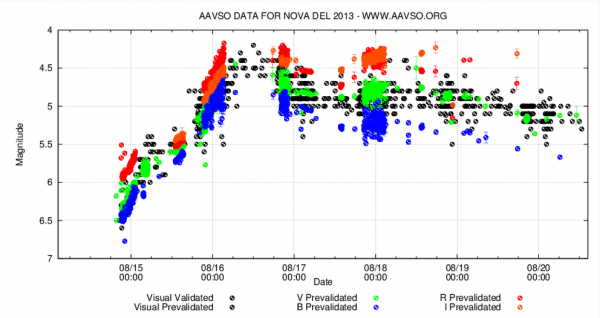Special Notice 410: Upcoming HST observations of V5668 Sgr
Note: this text is slightly different than the emailed version. No technical information was changed.
Note: this text is slightly different than the emailed version. No technical information was changed.
August 4, 2015: Dr. Gregory Sivakoff (U. of Alberta) has requested optical monitoring of the galactic microquasar V4641 Sgr beginning immediately, and continuing for the next 120 days, or until it is no longer observable from your location.
February 17, 2015
Event: Nova Scorpii 2015 = PNV J17032620-3504140 [V1535 Sco]
Discovered by: Tadashi Kojima, Gunma-ken, Japan
Discovery magnitude: unfiltered DSLR magnitude 8.1, using a 150-mm f/2.8 lens and digital camera
Discovery date: 2015 February 11.837 UT
Coordinates: RA: 17 03 26.18 , Decl: -35 04 17.6
February 13, 20115: Patrick Schmeer (SPK, Bischmisheim, Germany) reports the announcement on the CBAT Transient Object Confirmation Page (TOCP) of the discovery of a bright transient in Sgr [V5667 Sgr] on 2015 February 12.852 at an unfiltered magnitude of 10.9 by K. Nishiyama, using a 105-mm f/4 camera lens with an SBIG STL6303E CCD camera. Nishiyama notes nothing is present on a previous image from 2015 February 02.887. The transient has been independently confirmed with two pre-discovery images: by H.
No one knows what Nova Del 2013 will do next, but there are some tantalizing possibilities.

The current AAVSO light curve for Nova Del 2013
So far it appears Nova Del 2013 is a 'slow nova', type NB in VSX. By definition, it takes 150 days or more for a slow nova to fade by 3 magnitudes.
Sometimes "or more" can mean a lot of other exciting goings on.
For those who could not attend the AAVSO 2013 Spring Meeting in person but wish to take part, we will be broadcasting the following 2 events via GoToWebinar:
February 11, 2013: Observer Rod Stubbings (Tetoora Road, Vic., Australia) reports an outburst of the suspected old nova GR Ori (== Nova Ori 1916), observing the star at a visual magnitude of 13.0 on 2013 February 11.476 UT (JD 2456334.976). This observation was confirmed by observer Stephen Hovell (Kaitaia, New Zealand), who also reported the star at 13.0 on February 11.461.
Something you need to consider carefully, and a question that comes up often with new observers is "How often should I observe my program stars?" The answers depend largely on the type of stars you are observing. The following table is a general guideline. As you learn more about the different types of variables, and the personalities of some of the specific stars you choose to observe, you may decide to observe them more or less often than suggested here.
On April 2, 2006 H. Nishimura of Japan discovered a 10.5 magnitude nova based on two photographs taken with his Pentax camera. Similar photos (limiting magnitude 12) showed no object as recently as March 28 of that year, and CCD measurements taken soon after found the object had brightened to 8.5 on April 4/5 (Green 2006). The maximum occurred shortly thereafter, reaching magnitude 8.1. Pre-maximum spectra were obtained, and initial data suggested that this object was a fast Fe-II iron-type nova.